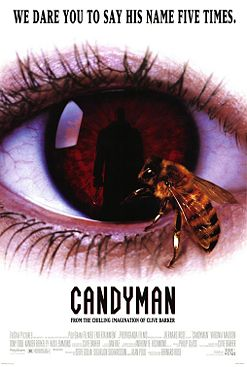The original Candyman (1992) was based on 'The Forbidden', a story by British author Clive Barker. Writer-director Bernard Rose took Barker's original tale, which is set in Liverpool, and transferred it to the impoverished, crime-ridden Chicago neighbourhood of Cabrini Green. Barker's theme focused on the British class system. Rose shifted the emphasis to American racial politics, making a horrific lynching the triggering factor in the creation of a unique creature of (fictional) folklore. And, yes, bees are involved. Among other things.
The plot of the first movie concerns a white graduate student investigating the urban legend of Candyman. Say his name five times in a mirror and he will appear - and kill you with his hook hand. The student, played by Virginia Madsen, becomes increasingly obsessed by the legend and eventually descends into apparent insanity. The film did well at the box office and spawned a couple of less well-regarded sequels.
The new Candyman is a direct sequel to the original movie, set in contemporary Cabrini Green. The area has been gentrified, and the protagonist is a black artist, Antony McCoy (Yahya Abdul-Mateen II) who has just moved into an upscale apartment with his girlfriend, Brianna Cartwright (Teyonah Parris). The legend of Candyman is front and centre from the start - Brianna's brother tells the story, or at least part of it. Because the spectral killer is in fact a combination of many victims of injustice, all still raging against the bigotry that killed them.
Antony is so impressed by this urban legend that he enters a new phase of creativity and exhibits some work based on the Candyman story. The show does not go well, however, foreshadowing Antony's increasing fixation on the legend and problems in his relationship with Brianna. After the gallery closes, its staff make the mistake of mocking the legend. Part of Antony's installation is a mirror and unpleasantness ensues. Anyone with an abiding dislike of art critics will get quite a buzz from this film.
From then on the movie does a brisk, robust job of linking Antony's apparent breakdown to the original movie. We find out more about Madsen's character and her demise, with much exposition done via shadow puppets (as in the original movie). This means some - but by no means all - of the violence is kept at one remove from the audience. Another clever device is that the Candyman can only be seen in a mirror and therefore is glimpsed rather than seen moving among his victims.
Some have found the end of the film a let-down. Mulling it over for a couple of days, I see their point, but I didn't find it disappointing. This is a story about hatred, rage, violence, and the traditional horror film ending - surprise, surprise, the Bad Thing isn't completely gone! - doesn't cut it.The legend evolves (via a very unpleasant scene that is nonetheless well-earned) and the Candyman becomes a strange kind of antihero. Or perhaps he always was.






No comments:
Post a Comment